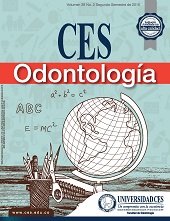Corrección de Maloclusión dental Clase II unilateral con Dispositivo de Anclaje Temporal Infracigomático
Resumen
La maloclusión dental clase II unilateral ha tenido varios enfoques de tratamiento a lo largo de la historia de la ortodoncia. Dichos enfoques han estado influenciados por tendencias, de acuerdo a las innovaciones en la tecnología y la eficacia del tratamiento instaurado. Actualmente el manejo ortodóncico para corregir las maloclusiones dentales unilaterales procura evitar en gran medida la extracción dental y que los aditamentos requieran de un mínimo de colaboración por parte del paciente. Por lo anterior el uso de Dispositivos de Anclaje Temporal (DAT) es la propuesta contemporánea. El siguiente reporte de caso tiene como objetivo ilustrar al lector acerca del manejo que se ha tenido hasta la fecha de la maloclusión dental de clase II unilateral y propone un manejo contemporáneo con el uso de DAT, basado en evidencia científica en un paciente masculino de 18 años de edad con diagnóstico de maloclusión dental clase II subdivisión derecha de 5 mm, logrando objetivos estéticos y funcionales.
Unilateral Class II malocclusion correction with infrazygomatic Temporary Anchorage Device
Unilateral class II malocclusion has been treated along the history of orthodontics by multiple approaches. The treatment tendencies reflect the development of technology and treatment efficiency. Temporary Anchorage Devices (TADs) are now considered the best way to treat unilateral malocclusion without extractions, because is not dependent of patient cooperation. The following case report of a male, 18 year old, patient, presenting a class II malocclusion of 5 mm in the right hand side, suggest a treatment approach based on the use of TADs and explains previous approaches to treat unilateral class II malocclusions. The treatment outcome was both aesthetic and functional.
Keywords:
Corrective Orthodontics, Malocclusion Angle class II, Orthodontic Anchorage Procedures. Dental Implants. Distalization.
Descargas
Referencias bibliográficas
2. Katz MI. Angle classification revisited 2: a modified Angle classification. Am J Orthod Dentofac Orthop. 1992; 102(3): 277-284.
3. Sinh QD, Rinchuse DJ, Zullo, TG, Rinchuse. DJ. Reliability of three methods of occlusion classification. American Journal of Orthodontics and Dentofacial Orthopedics. 1998; 113(4): 463-470.
4. Abida A, Amjad N, Hameedullah J, Gulzar B, Qalab A, Muhammad A. Prevalence of class ii malocclusions in pakistani sample — a study. Pakistan Oral & Dental Journal. 2010; 30(1): 96-100.
5. Thilander B, Pena L, Infante C, Parada S, De Mayorga C. Prevalence of malocclusion and orthodontics treatment need in children and adolecents in Bogotá, Colombia. An epidemiological study related to different stages of dental development. European Journal of Orthodontics. 2001; 23(2): 153-167.
6. Rebellato. J. Asymmetric extractions used in the treatment of patients with asymmetries. Semin Orthod. 1998; 4(3):180-188.
7. Young-Hee O, Hyo-Sang P, Tae-Geon K. Treatment effects of microimplant-aided sliding mechanics on distal retraction of posterior teeth. Am J Orthod Dentofacial Orthop. 2011; 139(4): 470-81.
8. Shroff B , Siegel SM. Treatment of patients with asymmetries using asymmetric mechanics. Semin Orthod. 1998; 4(3):165-179. mechanics
9. Abu JA, Butchart. CJ. An evaluation of the pendulum distalizingappliance. Semin Orthod. 2000; 6(2):129-135.
10. Locatelli R, Bednar J, Dietz V, Gianelly A. Molar distalization with superelastic NiTi wire. J Clin Orthod. 1992; 26(5):277-279.
Locatelli R, Bednar J, Dietz VS, Gianelly AA. Molar distalization with superelastic NITI wire. J Clin Orthod. 1992;26:277-279
11. Gómez S, Villegas C, Escobar S, Oberti G. Utilización del péndulo doble ansa soportado por tornillos endoóseos (reporte de caso). Rev CES Odont. 2005; 18(2): 41-45.
12. Oberti G, Villegas C, Rey D, Sierra A. Distalizador oseo-soportado sin minitornillos: C-DFD distalizer. Rev CES Odont. 2009; 22(2):43-48.
13. Oberti G, Rey D, Villegas C, Sierra A. Alternativa de tratamiento para la distalización de molares superiores con una barra traspalatina anclada a un mini-implante. Rev CES Odont 2010; 23(2):73-78.
14. Antoszewska J, Papadopoulos MA, Park HS, Ludwig B. Five-year experience with orthodontic miniscrew implants: A retrospective investigation of factors influencing success rates. Am J Orthod Dentofacial Orthop. 2009; 136(2): 158.e1-158e10.
15. Crismani , Bertlb M, Čelara A, Bantleona HP, Burstone C. Miniscrews in orthodontic treatment: Review and analysis of published clinical trials. Am J Orthod Dentofacial Orthop. 2010; 137(1): 108-113.
16. Lai TT, Chen MH. Factors affecting the clinical success of orthodontic anchorage: Experience with 266 temporary anchorage devices. Journal of Dental Sciences. 2014; 9(1): 49–55.
17. Wang YC, Liou. JW. Comparison of the loading behavior of self-drilling and predrilled miniscrews throughout orthodontic loading. Am J Orthod Dentofacial Orthop. 2008; 133(1):38-43.
18. Prabhat KC, Maheshwari S, Verma S, Tariq M, Zahid S. Treatment of Class II malocclusion with noncompliance miniscrew implantesupported distalization system. Journal of the World Federation of Orthodontists. 2012;1(2):79 - 86.
19. Oh YH, Park HS, Kwon TG. Treatment effects of microimplant-aided sliding mechanics on distal retraction of posterior teeth. Am J Orthod Dentofacial Orthop. 2011; 139(4):470-481.
20. Liou EJW, Chang PMH. Apical root resorption in orthodontic patients with en-masse maxillary anterior retraction and intrusion with miniscrews. Am J Orthod Dentofacial Orthop. 2010; 137(2):207-212.
21. Kim SH, Hwang YS, Ferreira A, Chung KR. Analysis of temporary skeletal anchorage devices used for en-masse retraction: A preliminary study. Am J Orthod Dentofacial Orthop. 2009; 136(2): 268-276.
22. Wu JH, Lu PC, Lee KT, Du JK, Wan HC. Horizontal and vertical resistance strength of infrazygomatic mini-implants. Int. J. Oral Maxillofac. Surg. 2011; 40(5): 521–525.
23. Pithon , Fonseca Figueiredo S, Oliveira DD. Mechanical Evaluation of Orthodontic Mini-Implants of Different Lengths. J Oral Maxillofac Surg. 2013; 71(3): 479-486.
24. Kilkis D , Bayram M, Celikoglu M, Nur M. Unilateral maxillary molar distalization with zygoma-gear appliance. Am J Orthod Dentofacial Orthop. 2012; 142(2): e1-e7.
25. Costa A , Pasta G , Bergamaschi G. Intraoral Hard and Soft Tissue Depths for Temporary Anchorage Devices. Semin Orthod. 2005; 11(1):10-15.
26. Chen CH, Nakano , Liou EJW, Maki K. A cone beam computer tomographic study of the cortical bone thickness in different class II facial patterns. Orthodontic waves. 2010; 69(4):131 – 137.
27. Liou EJW, Chen PH, Wang YC, Lin JCY. A computed tomographic image study on the thickness of the infrazygomatic crest of the maxilla and its clinical implications for miniscrew insertion. Am J Orthod Dentofacial Orthop. 2007; 131(3): 352-356.
28. Farnsworth D, Rossouw P, Ceen F, Buschang PH. Cortical bone thickness at common miniscrew implant placement sites. Am J Orthod Dentofacial Orthop. 2011; 139(4):495-503.
29. Chen YJ, Kao CT, Huang TH. Evaluation of ten extra-alveolar temporary anchorage device insertion sites by cone beam volumetric computer tomography: a pilot study. J Dent Sci. 2010; 5(1):21−29.
30. Guerrero JA, Vanegas JJ, Garzon DA, Casale M, Arzate H. Mechanobiology of Oral Implantable Devices. Biomaterials Science and Engineering. 2011; 15:309-336.
31. Ludwig B, Glasl B, Kinzinger G,Lietz T, Lisson J. Anatomical Guidelines for Miniscrew Insertion: Vestibular Interradicular Sites. Journa of Clinical Orthodontics. 2011; 45(3):165-174.
32. Aras B, Cheng LL, Turk T, Elekdag-Turk S, Jones AS, Darendeliler MA. Physical properties of root cementum: part 23. Effects of 2 or 3 weekly reactivated continuous or intermittent orthodontic forces on root resorption and tooth movement: a microcomputed tomography study. Am J Orthod Dentofacial Orthop. 2012; 141(2):29-37.
33. Paetyangkul A, Turk T, Elekdag-Turk S, Jones AS, Petocz P, Cheng LL, et al. Physical properties of root cementum: Part 16. Comparisons of root resorption and resorption craters after the application of light and heavy continuous and controlled orthodontic forces for 4, 8, and 12 weeks. Am J Orthod Dentofacial Orthop. 2011; 139(3):279-284.
34. Kapoor DN, Razdan A, Kannan S. Efective means of intraoral molar distalization – An overview. J Ind OrthodSoc. 2002; 35:131-142.
35. Bezrouk , Balsky L, Smutny M, Krulichova IS, Zahora J, Hanus J, Meling TR. Thermomechanical properties of nickel-titanium closed-coil springs and their implications for clinical practice. Am J Orthod Dentofacial Orthop. 2014; 146(3):319-327.
Descargas
Publicado
Cómo citar
Número
Sección
| Estadísticas de artículo | |
|---|---|
| Vistas de resúmenes | |
| Vistas de PDF | |
| Descargas de PDF | |
| Vistas de HTML | |
| Otras vistas | |



